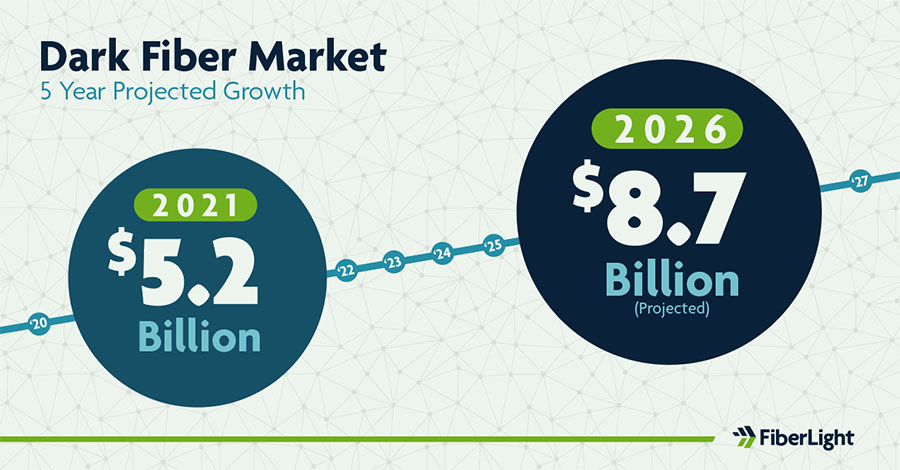Many businesses are turning to a dark fiber network as a way to save money while bandwidth, latency, and financial demands escalate.
Let’s imagine that a business finds itself with increasing connectivity needs, growing bandwidth requirements, and a push for decreased latency. To most, this probably sounds like a large order. The truth is, whether it’s an online gaming company that needs ultra-fast throughput and response times or a bank seeking greater network capacity to add more online banking applications, this scenario is pretty familiar to a lot of businesses these days. Especially as we enter the age of edge computing, the Internet of Things (IoT), and a host of other demanding data applications, the load on the back of any IT network is growing—and fast.
With escalating bandwidth, latency, and financial demands, many businesses are turning to dark fiber as a way to save money while creating future proof networks for their operations. Dark fiber holds a lot of potential to rejuvenate the capabilities of businesses across many key vertical industries, including healthcare, finance, education, and beyond.
What is Dark Fiber?
Put simply, dark fiber is pre-existing underground infrastructure that does not yet have the hardware or software that enable it to run services. While fiber optic cables that are actively sending data via light wavelengths are considered lit, the rest of the unused fibers laying in wait are deemed unlit—or dark.
A Little History
To get to the bottom of dark fiber, we have to travel way back to the 1980s and ’90s when the initial fiber installations were occurring. First, it’s important to know that the majority of the cost in laying fiber cables isn’t wrapped up in the cable itself but instead comes from physically digging down to plant the fiber. Foreseeing the need for growth in the future and not wanting to reiterate the expense, time, and difficulty of digging back down, the companies that were building fiber footprints during this time laid far more fiber than they actually needed. Of course, the same goes for any fiber builds that have occurred since, each adding to the excess. The surplus of infrastructure these companies left is today’s dark fiber, which can be bought or leased by other business entities. Some providers will build new dark fiber for businesses as well.

See if dark fiber is right for your business.
Dark Fiber’s Advantages
1. Scalability and Flexibility
There are many advantages associated with a dark fiber strategy, starting with its scalability and flexibility. A huge benefit of dark fiber is its ability to be broken down into a multitude of wavelengths through a process called wavelength-division multiplexing (DWDM). DWDM enables the transmission of multiple data streams along different light wavelengths, similar to how multiple planes can travel the same route simultaneously when flying at different altitudes. This means that businesses with smaller needs can get by just leasing a single wavelength, while larger companies can lease an entire fiber strand. Dark fiber can also easily accommodate the rapidly-scaling needs of today’s businesses.
2. Predictable Cost Structures for Increasing Bandwidth
In addition to enabling businesses to tailor costs based on wavelengths and strands, dark fiber also boasts a great cost structure for higher bandwidth needs when compared to traditional Internet Service Provider (ISP) payment approaches. ISPs usually charge by data usage, meaning if you use more you pay more. After a certain point of network growth, this arrangement starts to make less and less financial sense. Once a business surpasses 1 Gbps, dark fiber’s fixed payment with unlimited growth capacity becomes a better option for larger or expanding businesses than the cost of traditional commercial service, especially if the business expects more growth in the future.
3. Increased Performance
Dark fiber also showcases remarkable ability when it comes to speed. Nowadays, in sectors such as financial services, especially where algorithm-based trading is involved, latency is paramount. Traditional commercial internet services were built with many stops between point A and point B, mainly because each stop allows the provider to further monetize their services. However, when selecting dark fiber, enterprises can ensure they are getting the most direct, and therefore most efficient, path from end-to-end. Dark fiber also offers private networking, which means that businesses can quickly identify issues themselves and remedy them without waiting for ISPs to resolve the roadblocks.
4. Security and Redundancy
According to IDC, 53 percent of businesses have either brought or are thinking about bringing cloud workloads back on-premises to enhance security and performance. Dark fiber’s physically private networks also present a great option for companies looking to augment their data security. With dark fiber, businesses handle the hardware in-house and lease their own dedicated fiber or wavelength.
The dark fiber market size is projected to reach USD 8.7 billion by 2026 from an estimated USD 5.2 billion in 2021, at a CAGR of 11.0% from 2021 to 2026.

On top of the opportunity for a private network instead of going through the internet, which enables data to remain under the control of a single entity, this type of fiber offers safety in the form of augmented redundancy. Point-to-point connection and marked communications conduits underground help to safeguard dark fiber against many of the common types of outages that result from third-party damages. Additionally, when businesses depend on utilizing two different providers as part of their disaster recovery plan, there is a chance that those two providers, while separate in name, use overlapping infrastructure. With dark fiber, this risk is averted.
Going to the Dark Side
While dark fiber may be regarded as something that is only for service providers, or maybe even behemoth enterprise companies, it is being purchased more commonly these days than many businesses would assume. Able to meet a wide variety of business needs, this network strategy effectively future-proofs businesses, empowering them with the ability to meet the growing needs of their end-users with bolstered bandwidth, reduced latency, and more. While setting up a dark fiber system can admittedly be intimidating at first, choosing an experienced provider who can serve as a trusted partner to design, build, and deploy a custom network will offer businesses peace of mind while addressing current and future network requirements.
